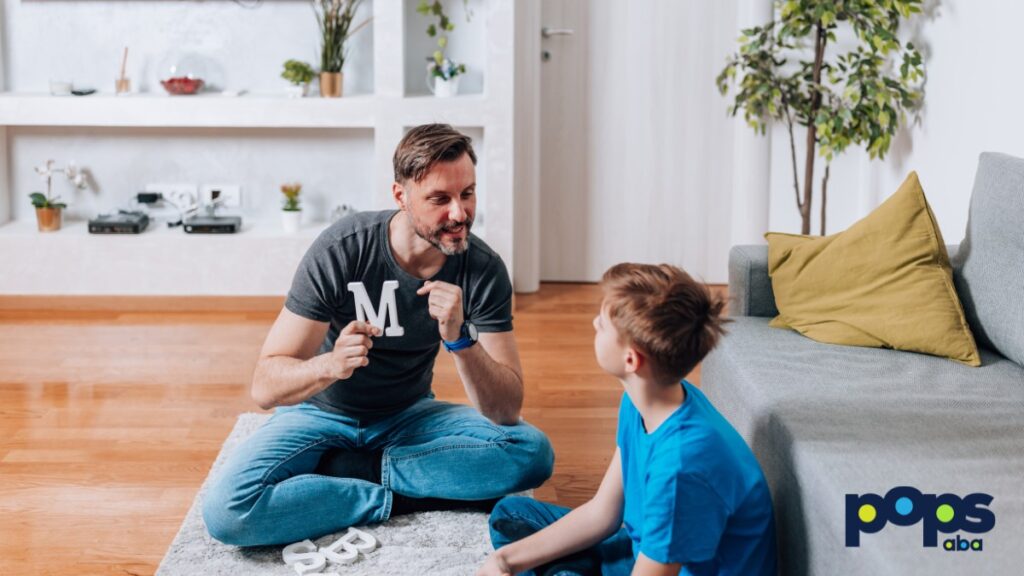Key Points:
- Children with autism often interpret and use body language differently from neurotypical individuals.
- Challenges in nonverbal communication can affect social interactions, but strategies like modeling and ABA therapy can help.
- Parents and caregivers can support children by teaching gestures, facial expressions, and personal space awareness in structured ways.
Nonverbal communication is second nature for most people, but for children with autism, body language can be hard to read. A shrug, a glance, or a frown might not make sense. Understanding how autism affects gestures, facial expressions, and social cues is key to helping children connect with others.
What Is Body Language in Autism?
Body language in autism refers to the unique ways individuals on the spectrum interpret and use nonverbal communication. Many children with autism experience difficulty recognizing facial expressions, understanding gestures, and maintaining appropriate personal space.
Some common differences include:
- Limited or avoided eye contact
- Unusual or absent facial expressions
- Rigid or repetitive gestures
- Difficulty interpreting others’ nonverbal cues
- Challenges with personal space awareness
These differences don’t mean that a child with autism doesn’t want to connect with others—they may simply communicate in a different way.

Why Do Individuals with Autism Struggle with Nonverbal Communication?
Nonverbal communication relies on a combination of instinct, social learning, and interpretation, which can be difficult for children with autism. Several factors contribute to these challenges:
1. Differences in Social Processing
Neurotypical individuals naturally pick up on nonverbal cues and social norms from a young age. However, many children with autism process social information differently, making it harder to recognize subtle cues like tone of voice or a raised eyebrow.
2. Sensory Sensitivities
Some children with autism experience sensory overload, making eye contact or close physical interactions uncomfortable. This can lead to avoiding social cues rather than actively engaging with them.
3. Reliance on Verbal or Routine-Based Communication
Many individuals with autism prefer clear, structured communication over abstract or implied meaning. Instead of reading body language, they may rely more on literal language, routines, or direct instruction to understand social situations.

Common Body Language Differences in Autism
Children with autism often interpret and use body language in ways that differ from neurotypical individuals. These differences can impact social interactions, making it harder to understand and respond to others effectively. Recognizing these challenges is key to providing the right support.
1. Eye Contact
Many children with autism avoid eye contact because it can feel overwhelming or distracting. Others may stare too intensely, not realizing that prolonged eye contact can make others uncomfortable. Instead of forcing eye contact, encouraging brief, natural glances can help a child engage in social interactions more comfortably.
2. Facial Expressions
Some children with autism may have neutral or limited facial expressions, even when experiencing strong emotions. Others may struggle to match expressions with feelings, making it difficult to recognize when someone is happy, sad, or frustrated. Teaching emotional cues through visual aids and role-playing can improve their ability to interpret expressions.
3. Gestures and Body Movements
Many children with autism use fewer gestures, such as waving or nodding. Some may engage in repetitive movements like hand-flapping or rocking, which serve as self-regulation tools. Encouraging purposeful gestures through structured activities can help them integrate nonverbal communication into daily interactions.
4. Understanding Personal Space
Personal space awareness can be inconsistent in autism. A child may stand too close or too far without recognizing social norms. Practicing spatial awareness activities can teach appropriate distance in conversations, helping them feel more at ease in social settings.
How to Support Children with Autism in Understanding Body Language
Parents, educators, and therapists can help children with autism improve their nonverbal communication skills using structured and supportive strategies.
1. Use Visual Supports
Many children with autism are visual learners. Tools like:
- Social stories explaining nonverbal cues
- Picture cards showing different facial expressions
- Video modeling of gestures and expressions
These can help children recognize and practice body language in a way that makes sense to them.
2. Model and Reinforce Nonverbal Cues
Children with autism benefit from clear, consistent modeling of body language. Parents and teachers can:
- Exaggerate facial expressions while naming the emotion (“I’m happy! Look at my big smile!”).
- Demonstrate gestures like waving or nodding and encourage imitation.
- Use structured role-play to practice common social scenarios.
3. Teach Personal Space Awareness
Some children may need direct guidance on how close to stand in social interactions. Helpful techniques include:
- Using hula hoops or floor markers to show appropriate space.
- Practicing greetings with peers and adjusting based on feedback.
- Explaining “arm’s length” rule for standing distance in conversation.
4. Encourage Communication Through Play
Play-based activities help children learn body language naturally. Activities like:
- Charades (guessing emotions based on facial expressions).
- Mirror games (copying movements and expressions).
- Puppet play (acting out social interactions).
These reinforce nonverbal communication in a fun, low-pressure environment.
5. Consider ABA Therapy for Structured Support
Applied Behavior Analysis (ABA) therapy provides personalized strategies for teaching social and nonverbal skills. Therapists use positive reinforcement and structured teaching methods to help children:
- Recognize and use facial expressions appropriately.
- Improve understanding of gestures and personal space.
- Develop more comfortable social interactions.
ABA Therapy Can Help Your Child Navigate Social Communication
At Pops ABA, we understand the challenges children with autism face in nonverbal communication. Our specialized ABA therapy programs focus on teaching body language, gestures, eye contact, and personal space awareness in a structured and supportive way.
Located in New Jersey and North Carolina, Pops ABA provides high-quality ABA therapy tailored to each child’s unique needs. We work closely with families to ensure that progress made during therapy sessions carries over into everyday life. If you’re seeking effective, evidence-based ABA therapy in North Carolina or New Jersey to support your child’s social development, contact Pops ABA today to learn more.
Let’s help your child gain the confidence to connect with the world around them.



